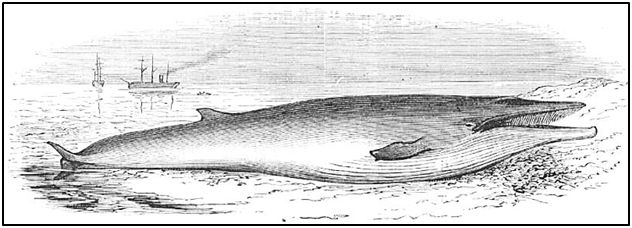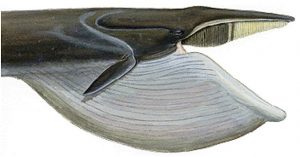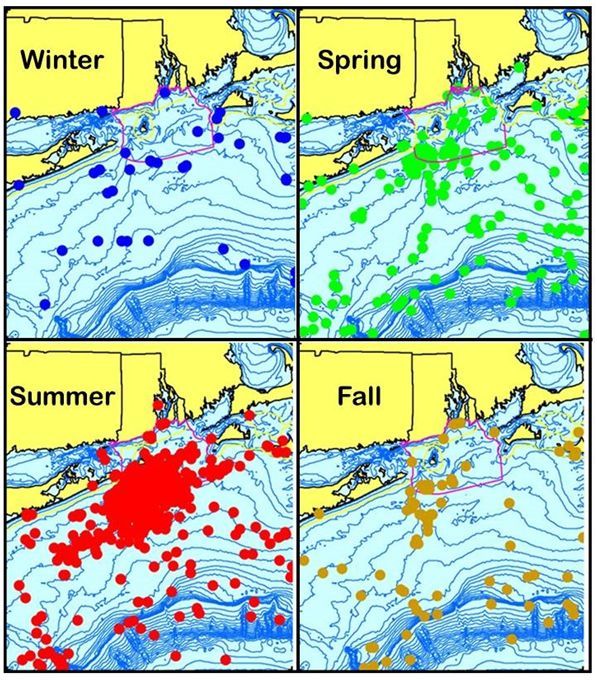by Robert Kenney
Although they don’t get the publicity that North Atlantic right whales or wandering belugas do, or the love from the public that humpback whales do, fin whales (also known as finbacks) are the most common large whale species in New England waters. If you were to take a whale-watching trip with the Frances Fleet from Galilee, Rhode Island, the most likely whale to see would be a fin whale. In fact, the whale-watching boat that worked out of Montauk, New York in the 1980s and 1990s was called the Finback for that reason. It is even possible to see fin whales from the shore in Rhode Island, usually in late fall when the herring are around; I’ve seen them from Narragansett Pier on more than occasion.

A typical rorqual, showing the slender form, distinct dorsal fin, and short baleen plates hanging from the upper jaw. The ventral grooves appear as lines on the lower jaw and belly. (from Natural History of the Mammalia of India and Ceylon, by Robert A. Sterndale; Thacker, Spink, and Co.; Calcutta, 1884),
Fin whales are broadly distributed throughout the world’s oceans, from the temperate regions poleward. Their range in the North Atlantic extends from the Gulf of Mexico, Caribbean Sea, and Mediterranean Sea in the south to Greenland, Iceland, and Norway in the north. The fin whales off the eastern U.S. and Nova Scotia are believed to comprise a stock that is more or less separated from other North Atlantic stocks—Newfoundland/Labrador, West Greenland, East Greenland/Iceland, Norway, western Europe, and Mediterranean. Fin whales off the northeastern U.S. are most abundant from spring through fall, with smaller numbers of animals remaining through the winter. Most of them are believed to migrate offshore and south during the winter.
Fin whales are classified as Endangered under the U.S. Endangered Species Act, as Federally Endangered on the Rhode Island state list, and as Endangered on the IUCN Red List. In my opinion, North Atlantic finbacks do not really fit the definition of an endangered species, and may never have, but there is a lot of politics involved in endangered species classification (perhaps a topic for another day). There is no precise estimate of the total abundance of fin whales in the North Atlantic, given their immense range. A probable range for their abundance across the entire North Atlantic might be around 50,000 to 60,000, perhaps more. The population off the northeastern U.S. likely includes about 5,000–6,000 fin whales.
On average, about one fin whale per year from the U.S./Nova Scotia stock dies from entanglement in fishing gear, and perhaps twice that number from ship collisions. Ship-struck fin whale carcasses are sometimes discovered in New York harbor or nearby in New Jersey, where they are carried in on large ships (unbeknownst to the crew). Other serious conservation concerns are rare, although some commercial whaling is still going on (see below). There are detectible contaminant levels in fin whales from waters near industrialized coasts such as the Mediterranean and North Atlantic, but they appear to be relatively low. Feeding relatively low on the food chain makes them less likely to accumulate harmful concentrations.
Whaling: The first person known to have tried to kill a fin whale in New England was Captain John Smith (yes, the same one of the Pocahontas legend)—off Monhegan Island, Maine, in 1614. He chased the whale for the better part of a day but was unable to catch up to it. Fast-swimming whales like finbacks simply could not be caught using vessels powered by sails or oars; whalers had to wait until the development of modern technology in the second half of the 19th Century. Modern whaling began in Norway in the 1860s with the marriage of harpoon cannons and exploding harpoons to steam-powered catcher boats. Norwegian whalers depleted local stocks of blue whales in about a decade, and switched to hunting fin whales. By the beginning of the 20th Century, Norwegian finback stocks were also depleted and the hunt expanded across the North Atlantic and eventually into the Antarctic, where the real carnage in the 20th Century took place.
Many thousands of North Atlantic fin whales were killed during the 19th and 20th Centuries. There was some whaling in U.S. waters, but it was relatively minor and ended around the turn of the century. There was also a brief period of whaling from three shore stations in eastern Canada in 1965–1971, with about 1,400 fin whales killed by whalers from Blandford, Nova Scotia. The U.S. ended commercial whaling in 1972 with passage of the Marine Mammal Protection Act, and Canada ceased whaling at about the same time.
In July 1982, the International Whaling Commission (IWC) approved a measure setting whaling catch limits to zero for all stocks beginning in 1986—establishing a world-wide moratorium on all commercial whaling. The moratorium was to be reviewed after five years, but the anti-whaling faction at the IWC has blocked any changes. Legal whaling since 1986 has been conducted only under (1) an exception for “aboriginal subsistence” whaling, (2) scientific research permits, or (3) objection (under the terms of the treaty, a nation that formally objects to specific IWC regulations is not bound by them). A subsistence hunt in West Greenland takes 10–15 fin whales per year. Iceland took 292 fin whales from 1986 to 1989 under a research permit, and subsequently withdrew from IWC membership. They rejoined the IWC in 2002, and in October 2006 announced the intention to resume small-scale commercial whaling. Seven fin whales were killed in Iceland in 2007, and more than 100 were killed each year in 2009, 2010, 2013, and 2014.
Description: Fin whales are the second-largest species of living whale, with adults 17–24 m long. Females are slightly larger than males, with maximum lengths of Northern Hemisphere adults averaging about 22.5 m for females and 21 m for males. There is evidence that the fin whales in continental shelf waters off the northeastern U.S. are somewhat smaller than whales from farther north. The mean adult length from animals measured from aerial photographs was 16.1 m, significantly smaller than fin whales taken in modern Icelandic whaling even after accounting for size selection by the whalers. Possible explanations include size differences between regional populations or habitat segregation by age—e.g., perhaps the largest adults remain farther offshore.
Fin whales and their cousins (blue, humpback, sei, minke, and others) belong to a different taxonomic family than the right whale that was the first subject of this series—the Balaenopteridae, or the “winged whales” (i.e., with dorsal fins). The collective term for the family is rorqual, from the Norwegian for “furrow whale.” Rorquals are much more slender than right whales—with very tapered heads; tall, curved dorsal fins; narrow, pointed flippers; and much shorter baleen plates. The term rorqual refers to the so-called ventral grooves, which are actually pleats in the body wall extending from the tip of the lower jaw back onto the belly. The ventral grooves are involved in their feeding behavior (see Natural History, below).
A fin whale has a very sleek, streamlined body with a flattened, tapered rostrum. The dorsal fin is about 60 cm tall, set about two-thirds or even three-quarters of the way back on the body. There is a distinct ridge along the back from the dorsal fin to the tail. There are 55–100 ventral grooves that extend back to the umbilicus.
The body color ranges from gray to brownish, with a much lighter belly. This dark-above/light-below counter-shading is believed to make marine predators much harder to be seen by their prey. Above the flippers, there is a pale, forward-pointing, V-shaped chevron on the back and swirls of lighter color on the sides. The most interesting thing about the appearance of fin whales is that they are all asymmetrically colored, with the lower jaw white on the right and dark on the left. This would be the equivalent of all dogs in the world having a dark ring around the left eye like “Petey” on “Our Gang.” (Although, if you look closely, the second dog who starred as Petey had the ring around his right eye.) The asymmetrical coloring even extends inside the mouth. All of baleen plates on the left side are dark gray, but the anterior one-third to one-half of the plates on the right are white.
Natural history: Fin whales appear to be similar to humpback whales in exhibiting maternally-directed habitat fidelity, where individuals return to feeding grounds visited with their mothers when they were calves. Even though individual fin whales are more difficult to photo-identify than humpbacks, multiple studies have shown relatively high re-sighting rates and concluded that females tend to return to the same feeding grounds consistently. Habitat use patterns by fin whales off the northeastern U.S. have shifted significantly in some years, as the whales track changes in the relative abundance of their prey species.
Fin whales are fast swimmers and capable of moving substantial distances in relatively short times. They normally swim at 5–8 knots (9–15 km/hr), but are capable of short bursts of 15 (28 km/hr) or even 20 knots (37 km/hr). One finback tracked by a radio-tag in 1980 between Iceland and Greenland traveled 2,095 km in ten days and covered 292 km in a single day.

A fin whale taking a huge mouthful of water and prey. Note the distended ventral pleats and the two-colored row of short baleen plates in the upper jaw. (illustration by Scott Landry, Center for Coastal Studies, Provincetown, MA; http://coastalstudies.org/about/stellwagen-bank-national-marine-sanctuary/marine-mammals/cetaceans/baleen-whales/; used by permission)
Unlike the skim-feeding right whale, fin whales and the other rorquals are referred to as “gulp feeders,” taking one giant mouthful at a time. The whale swims up to a school of prey in the water and opens its mouth. The ventral grooves expand into an enormous sack that engulfs a large volume of water and prey. Then the whale closes its mouth and muscles in the ventral body wall squeeze the water out, trapping the prey on the inside of the baleen. My friend, colleague, and former grad student George Klein, who died far too young in 2009, used to explain it to boatloads of kids while working as a whale-watch naturalist (much to the chagrin of their parents)—“You take a big spoonful of Jello with fruit in it and stick it in your mouth. Then you close your mouth and squeeze the Jello out between your teeth. The fruit stays on the inside.”
Fin whales often roll onto their right sides during feeding. Some have speculated that their asymmetric coloration was related to feeding, since it maintained their counter-shading and camouflage when they rolled to the right. However, symmetrically colored rorqual species also roll more often to the right than the left.
Southern Hemisphere fin whales feed mainly on shrimp-like euphausiid crustaceans (“krill”). North Atlantic and North Pacific finbacks prey upon a much wider variety of small, schooling prey, including many small fishes (herring, sand lance, capelin, sardine, etc.), squids, and krill.
Fin whale calves are born in the late fall and winter, probably far offshore, after a gestation of about 11 months. Length at birth is about 6 m and weight is 1,000 kg or more. Calves are weaned at 6–11 months old and doubled in length to 11–13 m. Female fin whales mature at 7–8 years of age and males at 6–7, with the corresponding body lengths in the Northern Hemisphere around 17–18.5 m in females and somewhat smaller in males. Full physical maturity in both sexes might not be attained until around age 25. The inter-birth interval is usually 2 or 3 years.
Historical occurrence: Fin whales are the most common large whale in the Rhode Island region at the present time, and likely were common historically. There are multiple 19th Century records from Rhode Island. Glover Allen’s 1916 monograph quoted a newspaper account from 16 August 1873—
“The skipper of the sloop Annie, of Saybrook, Conn., reports a large school of whales in close proximity to home. Monday, while midway between Southeast Point, Block Island, and Montauk, a school of whales, numbering probably thirty-five, was seen from the Annie’s deck, gamboling near the Block Island shore where they had been lured, it is supposed, by the prospect of a good feeding-ground. … The majority were large whales, some of them being not less than 70 feet in length.”
Large schools of whales were seen around Noman’s Land, Cuttyhunk, Gay Head, and Vineyard Sound in October 1874, chasing “great shoals of herring.” A stranding of a very large fin whale was reported near the life-saving station in “Wakefield” (i.e., the present Coast Guard House restaurant in Narragansett, which was not established as a separate town from South Kingstown until 1901) on 18 April 1880. Several whales were sighted off Block Island in early summer 1882. There were two sightings off Block Island in July of 1884—several whales on the tenth and about 20 at mid-month. A fin whale was sighted off Newport in 1885—“In the summer of this year a Finback was seen in Easton’s Bay, R.I., by a number of people, including Mr. Philip Peckham, Jr., on whose authority Major E.A. Mearns reports the fact to me.” An 1887 incident was included by Allen as a possible minke whale, but recorded in the Smithsonian data as more likely a juvenile fin whale:
“Major E.A. Mearns sends me the account of a capture of a small whale that was supposed to have been a ‘young Finback,’ but was perhaps a Little Piked Whale. The incident occurred in Narragansett Bay, R.I., but the exact date is not available. By some curious accident, the whale in rising to the surface caught its head between the stern and the propellor blades of the government steamer Munroe as it lay at the South Dock. In its struggles to free itself the whale nearly lifted the stern of the vessel out of the water. The Captain, seeing that the whale was caught fast, turned on full steam in order to dislodge it. This had the desired result, but the swiftly revolving blades inflicted such injuries on the whale’s head that it rushed upon a shoal at the head of Brenton’s Cove and became stranded. It was finally killed there by soldiers from Fort Adams. … It was said to have been a female, about thirty feet long.”
There were sightings of single whales off Newport on 2 June 1897 and 11 March 1899. Finally, a 15.5-m fin whale stranded at Point Judith on 28 August 1900.
Recent occurrence: Fin whales occur throughout continental shelf waters in our region in all four seasons. Sightings are strongly concentrated in summer (81%) and spring (12%) and in the area between Block Island and Montauk Point, however both the spatial and temporal patterns are strongly biased by reports from whale-watching boats from Montauk and Galilee, which generated more than 70% of all records. If the whale-watchers’ sightings are eliminated, the seasonal differences are far less dramatic (53% summer, 30% spring, 10% fall, and 7% winter). Even without the whale-watching data, sightings are still most concentrated in mid-shelf waters between Long Island and Martha’s Vineyard. It does make sense that whale-watchers would focus their cruises where they expect to find whales.

Aggregated sighting, stranding, and bycatch records of fin whales in the Rhode Island study area, by season, 1834–2008. The large numbers in summer come from whale-watching boats (from the R.I. Ocean SAMP technical report).
Strandings as a proportion of all records appear to be higher in the fall, which approximately corresponds to the expected time of weaning. Fin whales are the most commonly stranded large whale in and near the Rhode Island study area, with 28 records between 1970 and 2005. Within single years there were between 0 and 2 strandings, with one exception. There were 7 in 1983, with no clear explanation for the apparent anomaly. Possible reasons could be a drastic decline in prey resources, a disease event, a biotoxin event, some other natural or anthropogenic impact, or simply random variability in mortality.
One of the more interesting recent fin whale observations was in July 1983, when a headless carcass was seen drifting for several days. It was seen southwest of Block Island on the 27th and 5 km south of Point Judith on the 31st, with a number of great white sharks feeding on it. In August, as the dead whale continued drifting near Block Island, fishermen took the opportunity to target the feeding sharks. Three very large male white sharks—480, 484, and 497 cm—were harpooned, two even larger animals (estimated at 518 and 610 cm) were tagged, and at least three others were seen.
On 13 July 1989, a moderately decomposed immature female fin whale was found near Quonset Point; it was hauled up at Pier 2 in Davisville the following day. It had a fractured lower jaw and rope entangling the right flipper. On 27 July 1991, an 11-m whale was seen drifting near the south shore; it came ashore on East Matunuck State Beach on the 28th. On 30 April 1996, a 12.8-m fin whale stranded on Warren’s Point in Little Compton. Three fin whales stranded this century in Newport—one in Castle Hill Cove on 25 November 2002, one at Fort Adams State Park on 13 June 2004, and one at Brenton Point State Park on 24 December 2004. Elsewhere in our region, multiple strandings have also occurred in Connecticut, Massachusetts, New York, and New Jersey.
Coming next in Marine Mammals of Rhode Island: Pilot Whales